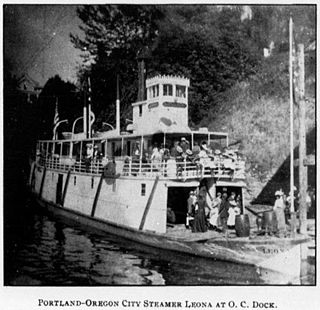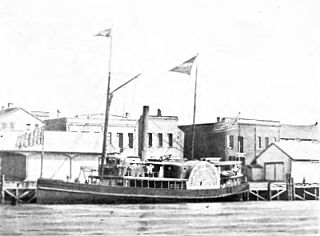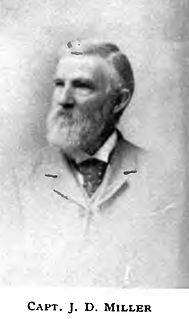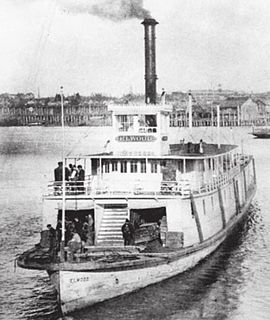
Steamboats operated on Grays Harbor, a large coastal bay in the State of Washington, and on the Chehalis and Hoquiam rivers which flow into Grays Harbor near Aberdeen, a town on the eastern shore of the bay.

Steamboats operated on Grays Harbor, a large coastal bay in the State of Washington, and on the Chehalis and Hoquiam rivers which flow into Grays Harbor near Aberdeen, a town on the eastern shore of the bay.
The first riverine steamboat to operate in the Grays Harbor area was the Enterprise, originally built in 1855 above Willamette Falls, at Canemah (now a part of Oregon City). Enterprise served on the Willamette River until 1858, when she was sent to the Fraser River in British Columbia where gold had been discovered. The Fraser Canyon Gold Rush was short-lived but lucrative for steamboat operators (Enterprise once made $25,000 in a single day), and when it ended, Enterprise was brought to Grays Harbor, where she was wrecked in 1862 on the Chehalis River. [1] [2]
In 1887, Henry H. McDonald, originally from Nova Scotia, arrived in the area and entered the steamboat business. [3] Steamboats owned by Captain McDonald included the tug Pilot and the sternwheeler Clan McDonald. Another sternwheeler operating in these waters was the T.C. Reed.
In about 1891, Dove served briefly on Grays harbor under George Emerson before being sold to Puget Sound interests. [4]
Willapa Bay is a large shallow body of water near the Pacific Ocean in southwestern Washington. For a number of years before modern roads were built in Pacific County, Washington, the bay was used as the means of travel around the county, by powered and unpowered craft. This article discusses steamboat navigation on Willapa Bay.

The history of steamboats on the Oregon Coast begins in the late 19th century. Before the development of modern road and rail networks, transportation on the coast of Oregon was largely water-borne. This article focuses on inland steamboats and similar craft operating in, from south to north on the coast: Rogue River, Coquille River, Coos Bay, Umpqua River, Siuslaw Bay, Yaquina Bay, Siletz River, and Tillamook Bay. The boats were all very small, nothing like the big sternwheelers and propeller boats that ran on the Columbia River or Puget Sound. There were many of them, however, and they came to be known as the "mosquito fleet."

Yaquina Bay, like Coos Bay, is a shallow coastal bay on the Oregon Coast in the Pacific Northwest of North America. The principal town on Yaquina Bay is Newport, Oregon. The Yaquina River flows into the bay. Until modern roads reached Newport in the late 1920s, the principal transportation method to and from Newport was by ship or boat.

Lake Washington steamboats and ferries operated from about 1875 to 1951, transporting passengers, vehicles and freight across Lake Washington, a large lake to the east of Seattle, Washington. Before modern highways and bridges were built, the only means of crossing the lake, other than the traditional canoe or rowboat, was by steamboat, and, later, by ferry. While there was no easily navigable connection to Puget Sound, the Lake Washington Ship Canal now connects Lake Washington to Lake Union, and from there Puget Sound is reached by way of the Hiram M. Chittenden Locks.

The sternwheeler Multnomah was built at East Portland, Oregon in 1885 and operated on the Willamette and Columbia Rivers until 1889 in the United States. She was later transferred to Puget Sound and became one of the better known steamboats operating there.

The steamboat Crystal operated in the early 1900s as part of the Puget Sound Mosquito Fleet.

The steamboat Fleetwood operated in the 1880s and 1890s on the Columbia River and later as part of the Puget Sound Mosquito Fleet.

The steamship Altona operated from 1890 to 1907 on the Willamette River in the U.S. state of Oregon. In 1907, she was transferred to Alaska.

The steamship Leona operated from 1899 to 1912 on the Willamette River in the U.S. state of Oregon. This vessel was original launched under the name McMinnville in 1899, and should not be confused with an earlier vessel named McMinnville, which ran on the Willamette River from 1877 to 1881.

The PS Eliza Anderson operated from 1858 to 1898 mainly on Puget Sound, the Strait of Georgia, and the Fraser River but also for short periods in Alaska. She was generally known as the Old Anderson and was considered slow and underpowered even for the time. Even so, it was said of her that "no steamboat ever went slower and made money faster." She played a role in the Underground Railroad and had a desperate last voyage to Alaska as part of the Klondike Gold Rush.

The Greyhound was an express passenger steamer which operated in 1890s to about 1915 on Puget Sound in Washington, United States. This vessel, commonly known as the Hound, the Pup or the Dog, was of unusual design, having small upper works, but an enormous sternwheel. Unlike many sternwheelers, she was not intended for a dual role as passenger and freighter, but was purpose-built to carry mostly passengers on express runs.

The Enterprise was an early steamboat operating on the Willamette River in Oregon and also one of the first to operate on the Fraser River in British Columbia. This vessel should not be confused with the many other vessels, some of similar design, also named Enterprise. In earlier times, this vessel was sometimes called Tom Wright's Enterprise after one of her captains, the famous Tom Wright.

James D. Miller was a steamboat captain in the Pacific Northwest from 1851 to 1903. He became well known for his long length of service, the large number of vessels he commanded, and the many different geographical areas in which he served.

The river sternwheeler Ramona operated from 1892 to 1908 on the Willamette River in Oregon, on the Stikine River running from Wrangell, Alaska into British Columbia, and the Fraser River, in British Columbia. This vessel should not be confused with the coastal steamship Ramona which also ran in Alaskan waters.
Chehalis was a sternwheel steamboat that ran on the Chehalis River, Puget Sound, and Lake Washington from 1867 to 1882. This vessel should not be confused with other steam vessels named Chehalis.

Montesano was a steamboat that was operated from 1882 to about 1903 in the coastal regions of Oregon and southwest Washington, including Astoria, Willapa Bay, Grays Harbor, the Chehalis River, Yaquina Bay and Coos Bay. The Montesano of 1882, built in Astoria, should not be confused with another, larger sternwheeler, also named Montesano, built in Cosmopolis, Washington in 1889.

Elwood was a sternwheel steamboat which was built to operate on the Willamette River, in Oregon, but which later operated on the Lewis River in Washington, the Stikine River in Canada, and on Puget Sound. The name of this vessel is sometimes seen spelled "Ellwood". Elwood is probably best known for an incident in 1893, when it was approaching the Madison Street Bridge over the Willamette River in Portland, Oregon. The bridge swung open to allow the steamer to pass. However, a streetcar coming in from the east end of the bridge failed to notice the bridge was open, and ran off into the river in the Madison Street Bridge disaster.

Governor Newell was a sternwheel-driven steamboat that operated from 1883 to 1902 in the Pacific Northwest.